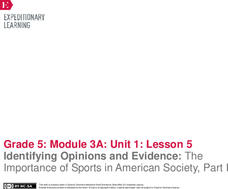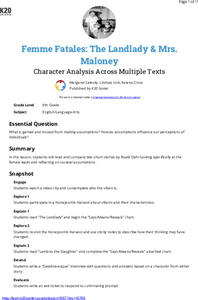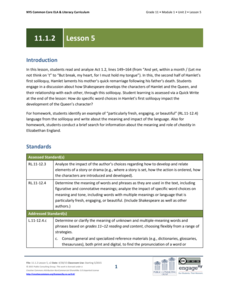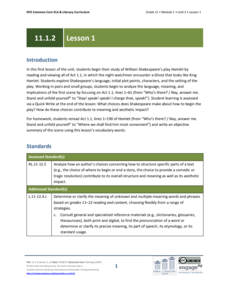EngageNY
Analysis, Reflection, and Introduction to the Painted Essay: The Invention of Television
Paint me a picture. Scholars complete a painted essay after examining the author's note in The Boy Who Invented TV. Learners identify various parts of the essay by using different paint colors and then complete task cards, using evidence...
EngageNY
Identifying Opinions and Evidence: The Importance of Sports in American Society, Part I
What's the gist? Learners determine the gist of an informational article about sports in America. They also participate in a jigsaw activity, rereading the article and discussing the author's opinion and supporting evidence.
EngageNY
Organizing Evidence and Writing an Opinion Paragraph: The Importance of Sports in American Society, Part II
Batter up! Using the resource, pupils continue reading an informational article about sports in America and identify evidence that supports the author's opinion. Scholars then write an opinion paragraph about sports.
EngageNY
Identifying Supporting Reasons and Evidence for an Opinion: Exploring Why Jackie Robinson Was the Right Man to Break the Color Barrier (Promises to Keep, Pages 26–29)
Breaking barriers is not an easy thing to do. Scholars read a section in Promises to Keep and summarize how Jackie Robinson broke the color barrier in baseball. They write the gist of the passage in their journals and then complete a...
PBS
Native American Pictographs
Scholars use a variety of common Native American pictographs to write a sentence. Through a series of pictures, readers decipher what the author has written. Colored pencils bring color to the assignment.
Livaudais-Baker English Classroom
Lord of the Flies: William Golding's Masterpiece
Spoiler Alert! An 18-slide presentation includes information about author William Golding, his experiences reflected in Lord of the Flies, a summary of the story, the political and religious allegorical levels of the novel, and the themes.
DocsTeach
Around the World with Ernest Hemingway
Ernest Hemingway was a traveler and added evidence of these travels to his works. An engaging activity asks readers to analyze 20 photographs of the author, then drag the images to the correct location on an interactive map.
National Endowment for the Humanities
Theme Analysis in A Christmas Carol
Why does Charles Dickens have Ebenezer go from scrooge to light-hearted and generous? From "Bah, humbug!" to "God Bless Us, Every One!" After rereading Dickens' preface to A Christmas Carol, learners analyze quotations from the tale that...
National Endowment for the Humanities
Themes in Lord of the Flies
William Golding's Lord of the Flies is the anchor text for a lesson plan that teaches readers how to distinguish between a literary topic and a literary theme. Using the provided worksheets, groups first chart some themes and propose a...
Facing History and Ourselves
Connecting to the Past
Young historians research the connections between their personal histories and the histories of our country to gain a deeper understanding of who they are. To begin, class members write about an object that they consider significant to...
Penguin Books
A Teacher's Guide to the Signet Classic Edition of William Shakespeare's Measure for Measure
Trying to get a hold on the author's intent in Measure for Measure can be a problem—no wonder the drama is considered one of Shakespeare's "problem" plays. This guide provides instructors with information about why the play is considered...
Penguin Books
Teacher's Guide: I Know Why the Caged Bird Sings by Maya Angelous
Maya Angelou's I Know Why the Caged Bird Sings is controversial. Like many other Angelou books, it is frequently challenged or banned from schools. In fact, Angelou is one of the most frequently banned authors in the United States. An...
Facing History and Ourselves
Community Is... Community Isn't
Scholars continue their exploration of the concept of community by first completing an anticipation guide and then engaging in a Four Corners activity to share their responses. They analyze an essay in which the author defines community...
K20 LEARN
Femme Fatales - The Landlady and Mrs. Maloney: Character Analysis Across Multiple Texts
Two stories by Roald Dahl, "Lamb to the Slaughter" and "The Landlady" provide readers an opportunity to compare stories by the same author. After a close reading of the stories, teams select a character from one of the tales, craft...
K20 LEARN
I Theme, You Theme, We All Theme For Ice Cream: Themes In Literature
Teach readers how to distinguish between a topic and a story's theme in a short lesson that uses the children's book, Should I Share My Ice Cream, as an exemplar. After listening to the story, pairs generate a list of topics covered in...
K20 LEARN
Who Are They Really?: Characterization In The Outsiders
Ponyboy, Johnny, Winston, and Darry come alive in a lesson that focuses on the details S. E. Hinton uses to characterize the Greasers and the Socials. The class first observes the actors' words; the thoughts revealed their effect on...
K20 LEARN
We've Got Character! Literary Analysis: Characterization
How authors bring characters to life and make them believable is the focus of a lesson on characterization. Readers closely examine passages from To Kill a Mockingbird and Dreamland Burning, noting details that reveal the character's...
K20 LEARN
Street Cred: Evaluating Sources
A instructional activity on evaluating sources of information teaches scholars to "think twice" before using a source. Researchers examine a resource's home page, author, and sponsor, as well as the date published and the documentation...
Anti-Defamation League
Bellen Woodard, Identity, and “Crayon Activism”
Scholars learn about a young child turn activist and author, Bellen Woodard. Learners discuss identity, the importance of representation, and how activism makes a difference. Small groups brainstorm ways to create change and the steps to...
EngageNY
Grade 11 ELA Module 1: Unit 2, Lesson 5
Scholars delve into Act 1.2 of Shakespeare's Hamlet. By completing a writing exercise and participating in a class discussion, they continue to analyze how the author develops the characters in the play.
EngageNY
Grade 11 ELA Module 1: Unit 2, Lesson 1
How can an author's decisions impact a text? Using an insightful resource, scholars begin their study of Hamlet by reading Act 1.1. They explore the language, characters, and setting in small groups. Upon finishing group work, pupils...
Mr. Ambrose
The Great Gatsby, F. Scott Fitzgerald
Good discussion questions, quizzes, and tests teach as well as assess. Readers of The Great Gatsby will learn much from the materials in a 36-page packet designed to help students prepare for the AP Literature exam. Included in the...
Curated OER
Hans Christian Andersen's Fairy Tales
A thorough lesson introduces learners to Hans Christian Andersen, the nineteenth-century author who created wonderful tales. They read the original texts of several of his stories, including "The Ugly Duckling," "The Little Mermaid,"...
Curated OER
Different People/Different Times
Learners read and compare two selections by two different authors with the theme man vs. nature. They complete a literary analysis paper comparing and contrasting the author's treatment of the topic with emphasis on setting, historical...
Other popular searches
- Authors Purpose
- Author's Purpose
- Author Study
- Authors Point of View
- Authors Purpose Powerpoint
- Authors Purpose Mini Lesson
- Author Research
- Authors Purpose Passage
- Georgia Authors
- Authors Study
- Teaching Author's Purpose
- Student Authors

























